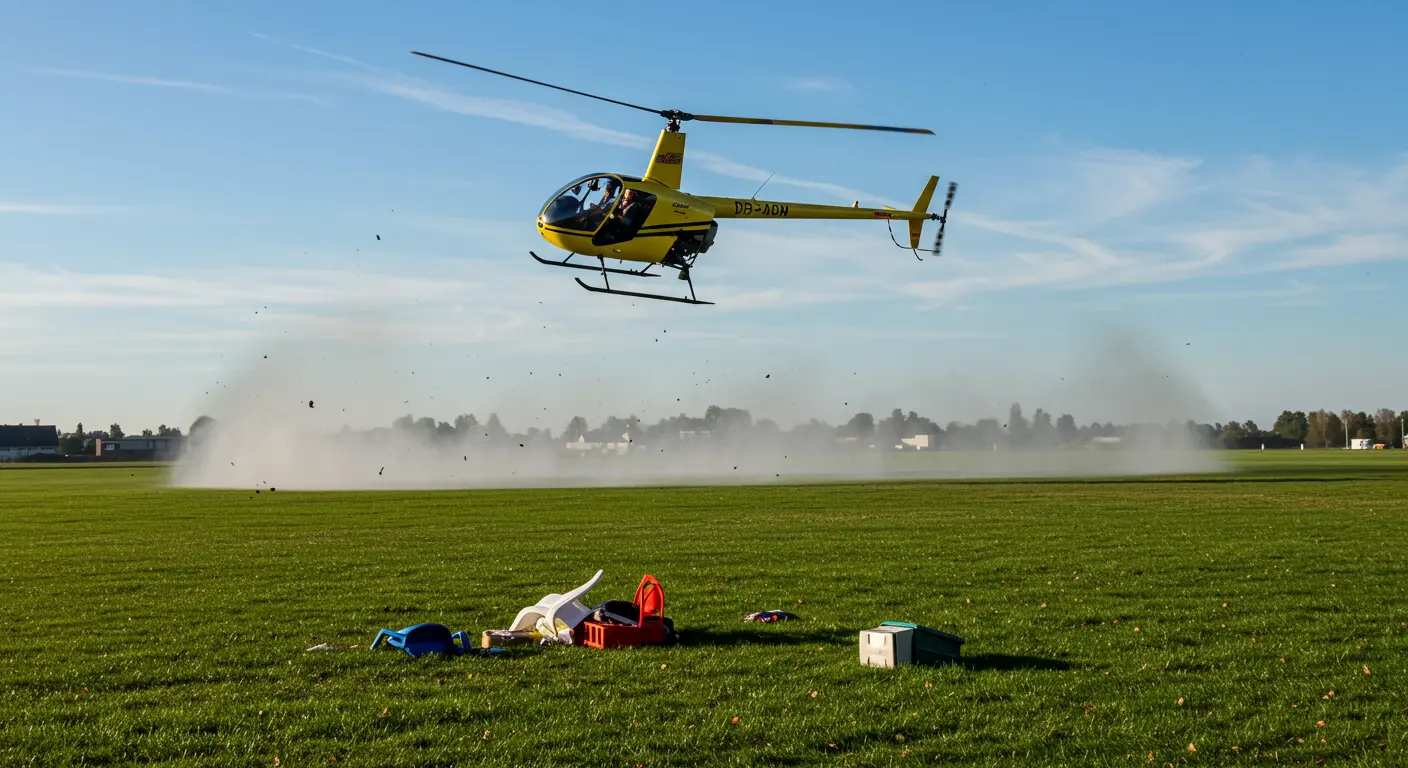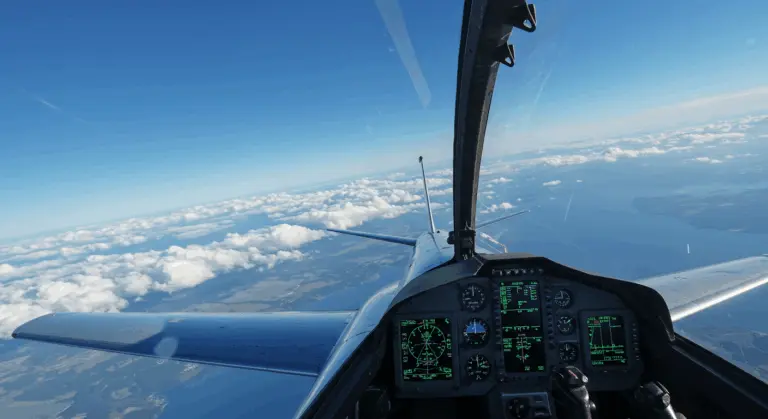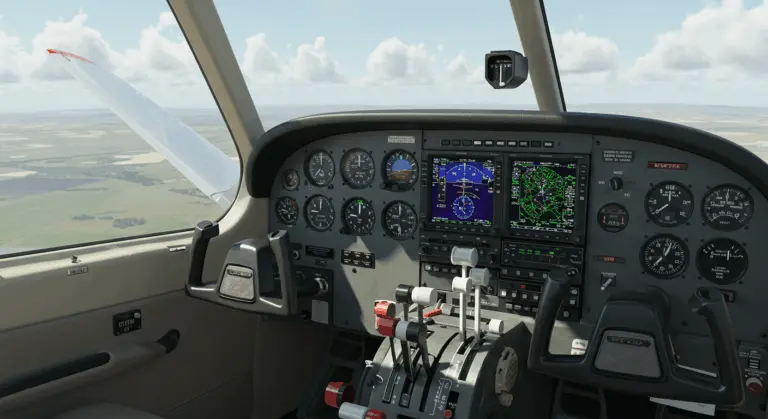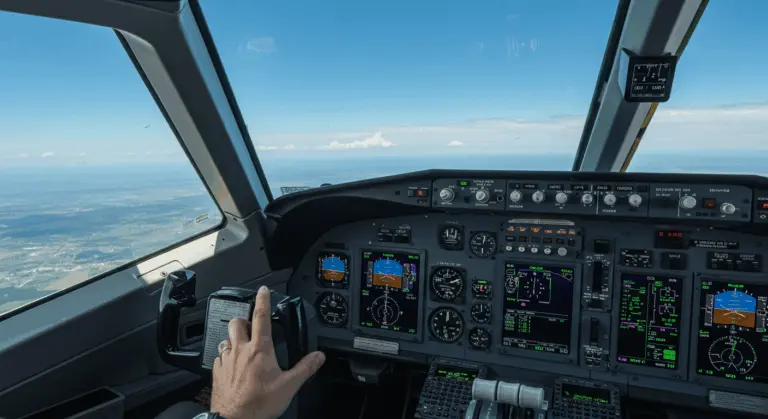Understanding Rotor Wash – Causes, Effects, and Dangers
What is Rotor Wash?
Rotor wash, also known as rotor downwash, is the powerful airflow generated by a helicopter’s spinning rotor blades. As these blades slice through the air to create lift, they draw air from above and accelerate it downward with tremendous force, forming a concentrated column of fast-moving air beneath the aircraft.
The intensity of rotor wash correlates directly with thrust output—the greater the power demand, the more ferocious the downwash becomes. Consequently, it is most intense during takeoff, landing, and hovering, when maximum thrust is required.
The force of this downward airflow can displace objects on the ground, obscure vision, and potentially unleash significant dangers to people, property, and even other aircraft in the vicinity. Pilots, ground personnel, and anyone working near helicopters must understand rotor wash behavior to ensure helicopter pilots, ground personnel, and anyone who might find themselves in proximity to helicopter operations.
Causes of Rotor Wash
Rotor wash emerges as a direct consequence of helicopter aerodynamics. To achieve lift, the spinning rotor blades establish a pressure differential—lower pressure above, higher pressure below—which forces air downward and generates the characteristic downwash.
-
Helicopter Weight: Heavier aircraft require more lift, resulting in stronger downwash.
-
Rotor Design: The rotor’s diameter and design affect downwash concentration. Smaller rotors tend to concentrate downwash into more focused, potentially hazardous patterns.
-
Operational State: Hovering produces the most powerful, direct downwash, while forward flight disperses it backward.
Environmental conditions also affect rotor wash behavior. Wind can redirect or amplify its effects dramatically, while air density—shaped by temperature, humidity, and altitude—directly influences its overall intensity.
Effects of Rotor Wash
Rotor wash creates substantial environmental effects. On the ground, it manifests as a powerful, turbulent wind radiating outward from the helicopter—strong enough to dislodge unsecured objects and transform orderly environments into chaotic scenes.
Vegetation provides a vivid demonstration of rotor wash power—grass flattens, bushes bow, and even small trees yield dramatically to its force. Water surfaces respond with equal drama, developing distinctive circular patterns of agitation that serve as valuable visual references for pilots operating over water.
The distinctive roar of rotor wash acts as both a byproduct and a natural warning system for the powerful air currents below. Experienced ground personnel can read these acoustic cues like a language, interpreting changes in pitch and intensity to anticipate the helicopter’s movements and intentions.
In environments rich with snow, sand, or dust, rotor wash becomes a powerful force that lifts particles, lifting debris skyward and creating visibility challenges that span from mild annoyance to perilous obscuration. This particulate suspension not only affects visibility but can also impact breathing and equipment operation in the immediate area.
Dangers Associated with Rotor Wash
Rotor wash poses significant operational hazards, with Foreign Object Debris (FOD) being a primary concern. The downwash transforms seemingly innocent objects—plywood sheets, loose equipment, portable toilets—into lethal projectiles, with recorded fatalities highlighting its deadly potential.
Visibility impairment presents another critical danger, particularly in environments with loose surface material. In desert or arid regions, rotor wash creates “brownout” conditions—a phenomenon where suspended dust creates an impenetrable veil of obscurity. Similarly, snowy environments can experience “whiteout” conditions as ice and snow particles are violently dispersed into blinding clouds. These conditions not only pelt anyone in the vicinity but can also create zero-visibility situations for pilots during critical landing phases.
Beyond debris hazards, rotor wash possesses enough raw power to force open helicopter doors, lift the noses of light aircraft, and scatter ground objects like toys. Risk peaks during hover or slow taxiing operations, when concentrated downwash spreads outward at velocities exceeding 30-40 knots—creating extreme peril for smaller aircraft.
Most concerning, rotor wash introduces chaos into what should be controlled operations. This unpredictability elevates accident risk across the board, threatening ground personnel, patients being transported, and bystanders who lack proper safety protocols.
Managing Rotor Wash Threats
Managing rotor wash hazards requires a comprehensive approach combining pilot awareness, rigorous operational procedures, and thorough environmental assessment. Pilots need to understand the scientific principles behind rotor wash for effective risk management, including how disc loading—the critical ratio of helicopter weight to rotor disc area—and air density directly govern downwash strength and behavior across varying conditions.
Pre-flight planning should include rotor wash considerations, particularly when operating in confined spaces or near loose materials, other aircraft, or vulnerable structures. Pilots must evaluate landing zones for potential hazards, including objects that could become airborne and surface conditions that could cause brownouts or whiteouts.
Pilots can use several techniques to mitigate rotor wash effects:
-
Maintain Hover Height: Use appropriate altitudes to reduce ground effect turbulence.
-
Use Gradual Power Changes: Avoid sudden power adjustments to prevent downwash intensification.
-
Position Aircraft Strategically: Direct downwash away from sensitive areas or personnel.
-
Ensure Proper Spacing: In multi-aircraft operations, maintain safe distances and sequencing to prevent interference.
Ground personnel and heliport managers can reduce risks through these measures:
-
Secure Debris: Establish clear protocols for securing all potential Foreign Object Debris (FOD).
-
Maintain Safe Distances: Enforce appropriate distances from operating helicopters.
-
Use Physical Barriers: Create barriers to shield sensitive areas when necessary.
-
Implement Training: Conduct training on rotor wash dynamics and safety procedures for all personnel working near helicopters.
Rotor Wash in Aviation Incidents
Real-world incidents clearly demonstrate rotor wash dangers. In a striking 2022 UK incident, an S92 search and rescue helicopter’s downwash obliterated portions of a helipad, demonstrating its potential for structural damage.
Another 2022 incident saw a fire extinguisher cover sucked into a helicopter’s fenestral, causing significant damage and highlighting the critical need to secure all ground equipment.
A 2013 incident demonstrated rotor wash’s extended reach when downwash from a departing helicopter caused its blades to strike another aircraft. This collision revealed how rotor wash effects can extend far beyond the immediate vicinity, creating invisible hazards for other aircraft.
In a particularly dramatic case, an SR20 light aircraft attempting to land merely 30 seconds after a Blackhawks helicopter’s departure was violently flipped by lingering rotor wash. The resulting crash injured the pilot and destroyed the aircraft, clearly showing the potent, invisible danger rotor wash poses to other aircraft.
Wild land firefighting operations have recorded a concerning phenomenon: helicopter rotor wash spreading fire along the ground during low-level operations. The vertical downwash generates surface winds that can dramatically reshape fire behavior, potentially endangering ground crews and transforming firefighting efforts into even more complex operations.
Several valuable resources offer comprehensive information on rotor wash:
-
Pilot Guides: Authoritative books like Understanding Rotor Downwash by Top Cinemas explain the physics and operational safety aspects.
-
Aviation Safety Agencies: The FAA and EASA publish official safety bulletins, advisory circulars, and best practices for hazard mitigation.
-
Flight Training Manuals: Standard helicopter flight manuals provide foundational knowledge on rotor wash effects and management techniques.
-
Specialized Training: Programs for ground personnel and emergency responders include modules on helicopter operational safety and rotor wash awareness.
-
Academic Research: Technical papers and simulation models from research institutions offer deep insights into the fluid dynamics of rotor wash.







